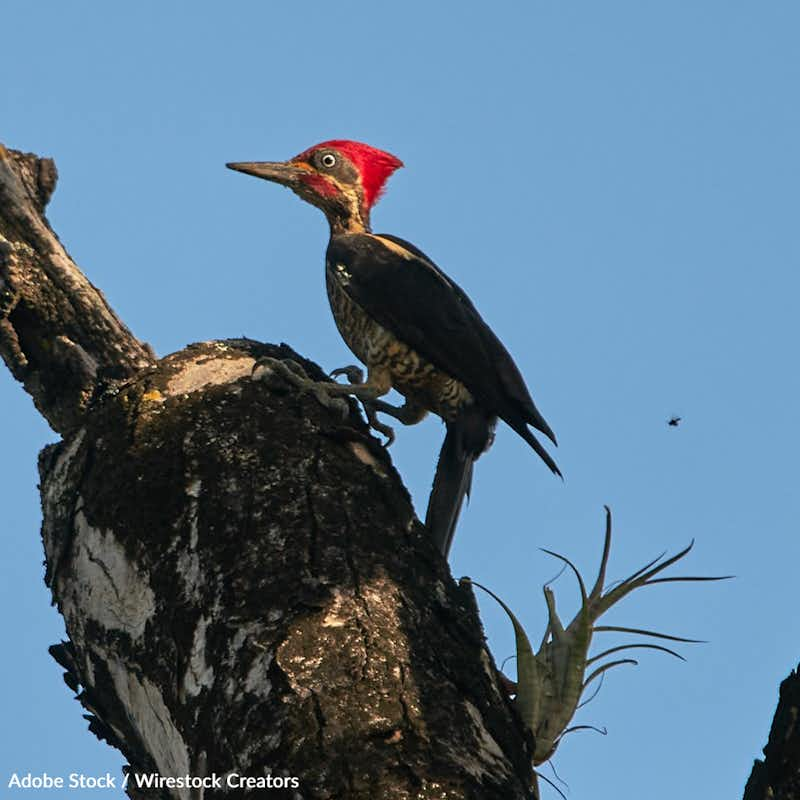Pledge to Save Native Birds
6,295 signatures toward our 30,000 Goal
Sponsor: The Animal Rescue Site
Take steps to reduce the impact of habitat destruction, climate change, and invasive species, which are the biggest contributors to the extinction of our native bird species.

The Ivory-billed Woodpecker, a majestic bird that once graced the hardwood bottomlands of the American South, is on the brink of extinction. After years of searching, the U.S. Fish and Wildlife Service has proposed officially removing it from the endangered species list and declaring it extinct1. This news comes as the ESA is proposing to remove 23 species from the list, 11 of which are birds. The ivory-billed woodpecker is one of the most famous and emblematic of these birds, and its loss is a tragedy2.
Other birds on the list include:
- Bachman's Warbler
- Bridled White-eye
- Kauai Akialoa
- Kauai Nukupuu
- Kauaʻi ʻōʻō
- Large Kauai Thrush
- Maui ākepa
- Maui Nukupuʻu
- Molokai Creeper
- Po'ouli
These species are in grave danger due to habitat destruction, climate change, and the introduction of invasive species. We need your help to prevent their extinction!
The Endangered Species Act (ESA) has been successful in preventing the extinction of more than 99% of species listed since it was enacted in 19733. The extinction of these species underscores the importance of the ESA and the need to conserve species before it is too late. Unfortunately, habitat destruction, climate change, and invasive species continue to threaten bird species, making the protections afforded by the ESA more important than ever.
The Ivory-billed Woodpecker, once the largest woodpecker in the United States, has not been seen for several decades, and the population was also once found in Cuba. The bird preferred large tracts of undisturbed, mature bottomland hardwood forests, which have been severely reduced due to logging and land-use changes4. The loss of its habitat is one of the primary threats leading to the extinction of the species5. Despite efforts to protect and restore the bird's habitat, such as the designation of the Singer Tract as a National Wildlife Refuge, it has not been enough to save the bird from extinction6.
Despite the lack of confirmed sightings, there have been numerous reported sightings of the Ivory-billed Woodpecker over the past few decades, with some supported by video footage and audio recordings. These sightings give hope that the bird may one day be rediscovered, but the challenges of bringing a species back from the brink of extinction are immense, and it will take a coordinated effort from governments, scientists, and individuals to make this a reality7.
Conservation groups and organizations are working hard to protect and restore the bird's habitat, including the creation of new protected areas, such as the Big Woods Conservation Partnership in Arkansas8. We urge you to join us in supporting these efforts and doing everything we can to prevent the extinction of these and other endangered species.
The loss of the Ivory-billed Woodpecker and other species is a tragedy that must be prevented. We must act now to prevent their extinction and ensure that future generations can enjoy these majestic creatures. The ESA has been incredibly successful in preventing extinctions, but its protections are needed now more than ever. We call on everyone to join us in supporting conservation efforts and advocating for policies that protect endangered species.
Together, we can make a difference and save these incredible creatures from extinction. Join us in the fight to protect the Ivory-billed Woodpecker and other endangered species before it is too late. Take the pledge to save our native birds!
- Ian Fischer, U.S. Fish & Wildlife Service (6 July 2022), "Service Announces 6-Month Extension on Final Decision for the Ivory-billed Woodpecker."
- U.S. Fish & Wildlife Service (29 September 2021), "U.S. Fish and Wildlife Service Proposes Delisting 23 Species from Endangered Species Act Due to Extinction."
- World Wildlife Fund (2023), "The US Endangered Species Act."
- Gabriel Mac, Audubon (May - June 2016), "Can the Ivory-Billed Woodpecker Be Found in Cuba?."
- U.S. Fish & Wildlife Service, "Ivory-billed Woodpecker."
- Stephen Lyn Bales, Smithsonian Magazine (September 2010), "A Close Encounter With the Rarest Bird."
- Bill Bowden, Arkansas Democrat Gazette (3 August 2022), "Video presented as evidence ivory-billed woodpecker still exists."
- Elliott Swarthout & Ron Rohrbaugh, BirdWatching (2 October 2018), "What’s next for the Big Woods Conservation Partnership and the Ivory-billed Woodpecker."
The Pledge:
As a concerned individual, I understand we must take collective action to protect our native bird species from extinction. The rapid decline in bird populations, including the endangered species, should alarm us all. By taking small steps and making conscious choices, we can contribute to protecting and conserving these precious birds for future generations to enjoy.
Here are ten actions I will take to help save native American birds:
- Prevent window collisions: Birds can easily collide with windows, causing injuries or death. I will put up window decals or film to make windows visible to birds.
- Reduce or eliminate pesticide use: Pesticides can be harmful to birds and their food sources. I will try natural pest control methods or reduce pesticide use in my garden.
- Reduce single-use plastics: Plastic pollution harms bird populations, and reducing single-use plastics can make a difference.
- Plant native species: Native plants provide food and shelter for birds. I will plant native species in my yard or garden to help support local bird populations.
- Support sustainable agriculture: Agriculture practices that prioritize sustainability can benefit birds and their habitats.
- Avoid purchasing products made from threatened bird species: I wil be conscious of the impact of my consumer choices and avoid buying products made from threatened bird species.
- Participate in citizen science programs: Citizen science programs help collect data on bird populations and migration patterns.
- Advocate for bird conservation policies: I will contact my local representatives to support bird conservation policies and regulations.
- Support conservation efforts: I will donate to organizations working to protect and restore bird habitats, such as Project Peril, a program of Greater Good Charities, which partners with the best non-profits devoted to combating habitat loss, stopping the illegal wildlife trade, and preventing human-animal conflict.
- Spread awareness: I will educate others on social media and in real life about the importance of bird conservation and the actions they can take to help protect these amazing creatures.
By taking these ten actions, I will make a positive impact on bird populations in our communities and beyond.
Pledged by,
 Welcome Back! Log In to Continue
Welcome Back! Log In to Continue